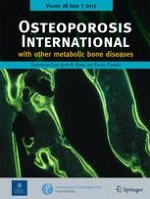01-07-2017 | Original Article
Comparison of two automated assays of BTM (CTX and P1NP) and reference intervals in a Danish population
Published in: Osteoporosis International | Issue 7/2017
Login to get accessAbstract
Summary
Bone turnover markers are used for monitoring osteoporosis treatment. Therefore, we evaluated the agreement between different assays for CTX and PINP and established reference intervals in a cohort of 2300 individuals. We found poor agreement between assays and different reference intervals. This highlights the importance of harmonization of the assays.
Introduction
Two reference markers for bone turnover have been proposed: CTX bone resorption and P1NP for bone formation. The purpose of the current study was to establish reference intervals for the two markers in a Danish cohort and to determine the agreement on the two platforms.
Methods
Fasting sera from 2308 individuals (1250 males and 1058 females, age range 24–76 years) participating in the Health2006 study were analyzed for CTX and P1NP using the automated IDS-iSYS analyzer and the automated Cobas e411 analyzer. Participants in anti-osteoporotic treatment were excluded, while subjects on hormonal contraceptives were included.
Results
There was significant disagreement between both the two P1NP assays with a mean difference of −3 μg/L (LoA −19 to 14) (p < 0.001) and the two CTX assays with a mean difference of 13 ng/L (LoA−187 to 214) (p < 0.001). For CTX, there was a systematic bias: at low values, Cobas measured a higher value than iSYS and at higher concentrations, iSYS measured increasingly higher values than Cobas. Based on the results, we propose three reference intervals for each sex: 25–29, 30–39, and 40–80 years for men, and 25–29, >30 (pre-menopausal), and >30 years (post-menopausal) for women.
Conclusions
There is significant disagreement between the IDS-iSYS and Roche Cobas assays for both reference markers. Consequently, the reference intervals for an adult, healthy population are different depending on the analysis method used. Therefore, repeated measurements of patient samples used for monitoring of treatment should be done on the same assay. Moreover, assay-specific reference intervals should be used. Harmonization of assays for BTM is highly warranted.





